All you need to know about your products!

| 3DNews Vendor Reference English Resource - All you need to know about your products! |
||||||
 |
||||||
|
|
||||||
Abit AN7 (nVidia nForce II 400 Ultra) ReviewAuthor:Date: 07/05/2004
The era of the SocketA is coming to an end. The last processor (Athlon XP3200+) was released quite a long time ago, and the only reason these processors are mentioned is the scheduled price reduction announced in the news. Similar situation is on the motherboard market: a complete lack of novelties. Things might get improved through a release of new chipsets (VIA KT880 and nVidia nForce2+ MCP-S), but unfortunately no new products have appeared so far on the retail shelves. Therefore, to maintain interest to the fading platform, manufacturers are producing partly renewed versions of old motherboards. In particular, Abit AN7, Epox 8RDA3+ rev3.1 and Soltek FRN3(L) motherboards have hit the retail. The most interesting of them is the Abit board, which we'll be reviewing today. In this review, the Abit AN7 board will be compared versus Abit NF7-S as one of the best motherboards (primarily, at overclocking) built on the nForce 2 chipset. Also, we'll give a special focus to the features of the mGuru chip which is the main distinctive feature of AN7 motherboard. Abit AN7 Specifications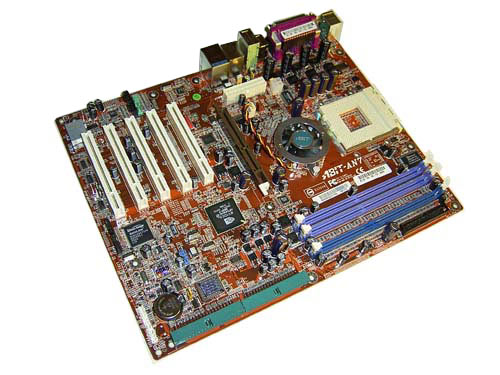
PackageThe board is packaged in a new-style box, where the focus is given to the mGuru chip image: 
Package bundle
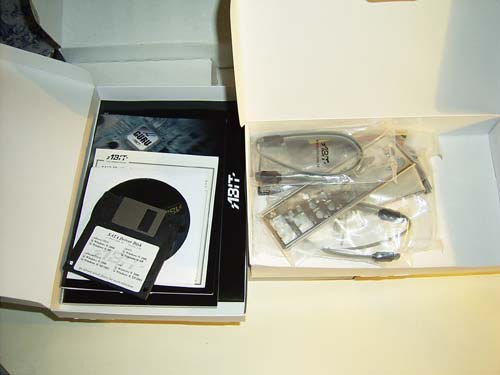
The board's package bundle can't boast abundance of components, if offers only the most needed: cables, a cap, a driver CD (plus a separate RAIDE drivers diskette) and customary SerialATA cables with respective power adapter. The bundled CD has a complete set of drivers, as well as a set of utilities to control the mGuru features. These are the system monitoring utility Abit EQ, the utility for overclocking from within Windows - OC Guru, the program for controlling the audio functions - Audio EQ, the program for controlling the fans - FanEQ, and finally the program for getting technical support - BlackBox. A special focus is given to the documentation. The board comes bundled with 3 brochures: a very detailed user guide (the introduction is written in six languages, including Russian), a brief assembly guide and a booklet describing the mGuru features. Abit AN7 Board FeaturesThe design of Abit AN7 makes a radical difference from the Abit NF7-S model. Nevertheless, all the PCB flaws have not been fixed so far. In particular, the power connectors are positioned almost in the center, with the processor socket very close to the board's edge, and the latches of the memory slots might be blocked by a long AGP video card. 
There are improvements, though: e.g. the IDE connectors are mounted in the board's bottom end and are aimed parallel to its plane. This makes connection of cable connections much easier. Now let's look at the area around the processor socket. 
The vacant area around the socket is quite comfortable to install massive coolers. Anyway, we came across some issues when installing the popular cooler Zalman 7000-A (the capacitor was a hindrance). But after some modifications made to the fastening we were able to install the cooler, since the board offers four assembly holes. Note also that under the socket teeth there are plastic strips preventing the board from damages. Like all modern SocketA boards, Abit AN7 offers support for hardware protection against overheating. Once the core temperature exceeds 100-110 C, the system shuts down. Actually, this is an extreme situation which comes up if you forgot to plug in the cooler (or simply didn't install it at all :). As regards the temperature monitoring, Abit AN7 offers an interesting peculiarity. With early BIOS versions, the processor temperatures rose too fast depending on the load. This allowed to assume that data is taken straight from the thermal sensor of the processor core. However, in later BIOS versions the temperature started changing at some delay, and the variation value did not exceed 3-4 С. In the end, during all the tests I wasn't able to observe the temperature exceed 53C, whereas the real processor core temperature in XP3200+ with a Titan Cu5TB cooler should be about 65-70 C as the Vcore rises. Therefore, we can conclude that temperature data is indeed taken straight from the thermal sensor but undergo additional "processing" through the BIOS and reduce the temperature (clearly, this is done because of the false care about the user; so as to relieve him/her from the trouble of cooling efficiency). What is especially sad is that this practice of temperature reduction is increasingly applied extending to Socket754 motherboards as well. This is absolutely understandable: currently, AMD processors offer much lower heat emission than Northwood/Prescott Pentium4 processors do. And motherboards designed for Intel processors display the temperature precisely enough. As regards the cooling of the chipset, there is nothing to complain. On the North Bridge, there is a big cooler with a proprietary protective grid. 
The cooler is plugged in to the 3-pin NBFAN1 connector. At the same time, not only does the board monitor its rotational speed, it also allows the user to decelerate the cooler due to the FanEQ technology. The same feature is available for the processor cooler and is plugged in to the CPUFAN connector. The other cooler connectors (SYSFAN1, FAN4, FAN5) lack such feature, unfortunately. Below the North Bridge, there are 3 DIMM slots; the maximum memory capacity makes up 3 GB. 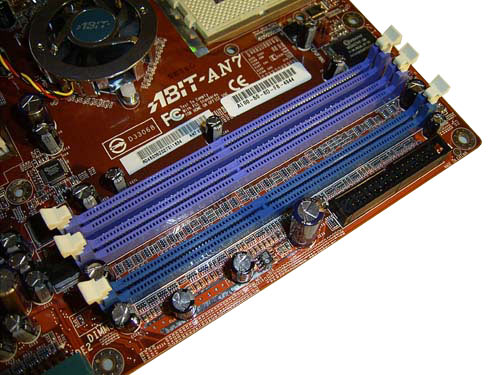
Near the battery, there is a red LED indicating voltage on the slots. Once the board starts up (or is still in the stand-by mode), another, green, LED lights up. 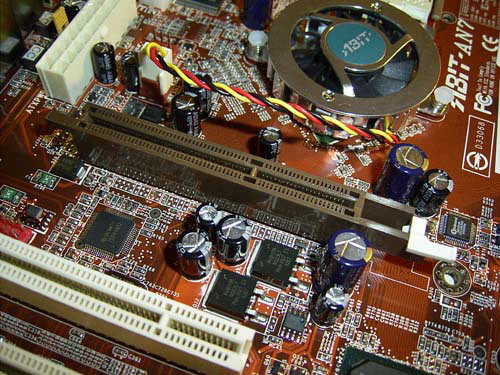
Only 1.5V (or 0.8V) AGP 4x/8x video cards are allowed into the AGP slot. Besides it, there are 5 PCI slots onboard, with the first one positioned far enough from the AGP slot. 
This makes installation of video cards with a massive cooling device (e.g. Gigabyte GV-N595U-GT) a breeze, with the PCI1 slot left vacant. In this case, the only issue will be plugging in a header for a Firewire port. Expansion optionsSince the south bridge MCP-T lacks support for the SerialATA, engineers at Abit implemented the interface in a traditional way - through installing an additional controller. 
This is a quite popular dual-channel SerialATA/RAID Sil3112 controller made by Silicon Image with support for RAID of levels 0 and 1. Anyway, the MCP-T south bridge can't boast other advantages. The most essential of them is the integrated audio of superb quality with support for the SoundStorm technology. 
In practice, this gives audio quality comparable to Creative Live 5.1, as well as the minimum performance drop with the EAX enabled. As the codec, the latest ALC658 chip is used (on the Abit NF7-S, the outdated ALC650 codec was installed). 
Besides, use of the MCP-T south bridge gives support for the IEEE1394 ("Firewire") bus. As a result, Abit AN7 offers two respective ports: one mounted on the board's rear panel, with the other connected through a header (missing in the package bundle). 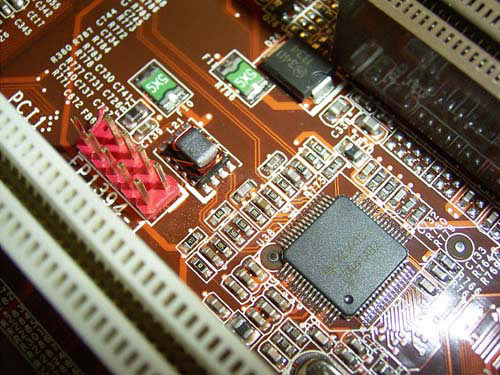
As the physical interface, the TSB41AB2 chip is used which is positioned between the AGP and PCI1 slots. The FP1394_1 connector to which a header is plugged in is also positioned here. The board also offers support for the USB 2.0 bus. There are six USB 2.0 ports altogether, four of which are mounted on the rear panel, with 2 more connected through a header (missing in the package bundle). 
The remaining expansion options are the RTL8201BL network controller (physical interface of the MCP-T). 
The board's rear panel has an unusual configuration, with the COM2 port missing. Instead it, there are SPDIF in/out connectors. 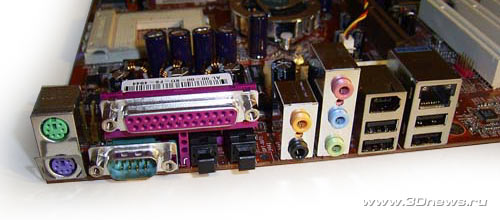
Traditionally, a jumpers layout diagram: 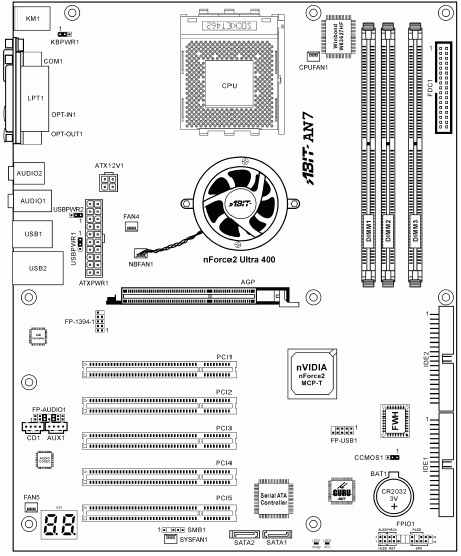
There are quite a number of jumpers on Abit AN7: the CCMOS1 is used for clearing the CMOS (positioned near the battery), the KBPWR1 is used for waking up the system on a keyboard pulse, the USBPWR1 and USBPWR2 are used to wake up the system on USB response (positioned not in the best way, near the main power supply). All the jumpers have plastic tails to make the installation more amenable. Of additional features, note the 7-stage POST indicator which proved to be an integral part of any Abit motherboard. 
All the other additional features are gathered in the mGuru chip installed near the battery. 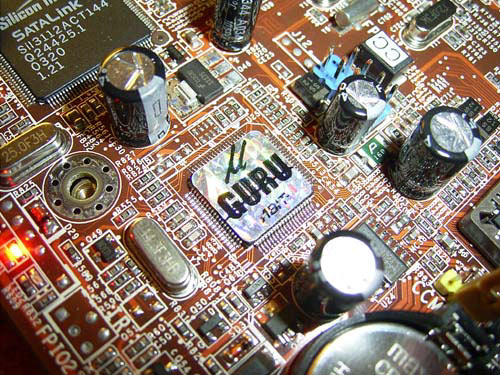
In fact, the mGuru chip supports only two useful functions. These are monitoring the rotational speed of the fans, and storing the BIOS setting profiles (the latter will be referred to in the next section). The remaining "mGuru technologies" are merely marketing toys. BIOSThe BIOS of Abit AN7 is based on the Award-Phoenix BIOS version. 
Now looking into the section dealing with the RAM operating parameters. 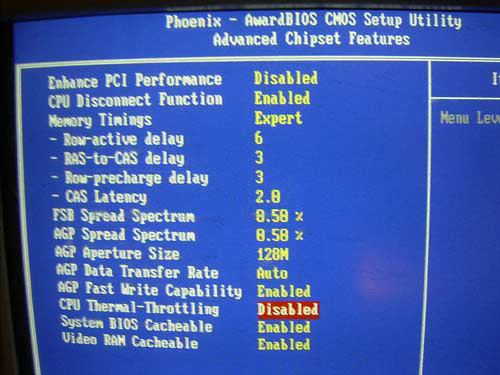
The user can vary the standard memory latency timings customary for nForce II based motherboards ("SDRAM Cas Latency" and "Precharge to Active"(Trp), "Active to precharge" (Tras) and "Active to CMD"(Trcd)) within very wide ranges. Now a few words on the system monitoring tools which due to the abundance of parameters are divided into four sections. 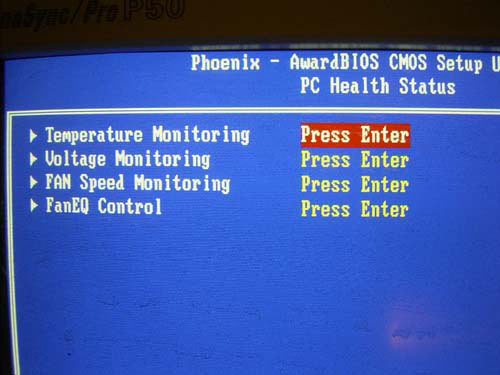
First off, the "Temperature Monitoring" group that displays the current temperature values of the processor, system and the power module. Also, the user can activate the processor overheat signalization and enable the automatic system power-off feature upon attaining a certain temperature. 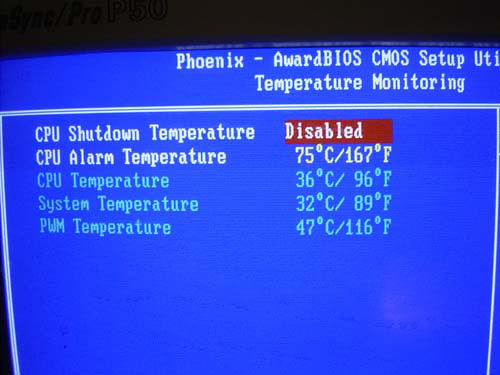
The second section is purely informative and displays the current voltage levels. 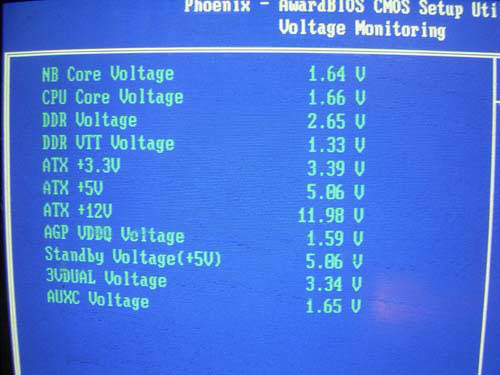
Then, look into the "Fan Speed Monitoring" section responsible for the system fans. 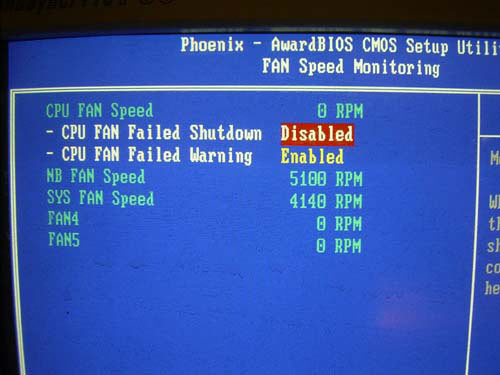
On the board, there are 5 fan connectors, and all of them offer the feature for determining the rotational speed. Besides, there is a feature of emergency system power-off in case the processor cooler fails to operate. Temperatures, as well as other parameters can be monitored from within Windows. For that, there is the Abit EQ utility: 
The program is very nice to looks at, but is somehow awkward. In particular, there is no way displaying the processor temperature (or other parameters) in the system tray. Once we try to use the Motherboard Monitor software, we are in for disappointment: the latest version (v5.3.6.0) can't "see" the sensor chip on Abit AN7. And finally the most interesting section - the "FanEQ Control". 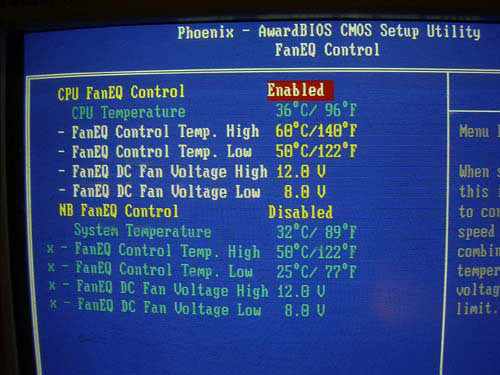
With it, the user can flexibly control the speed of the processor cooler and the cooler on the chipset. In particular, you can set the low temperature threshold (this parameter in the BIOS is called "FanEQ Control Temp. Low"). Until the processor temperature reaches that value, the fan will be rotating at the minimum speed. That is, user-selected voltage will be applied to it (in the BIOS, this parameter is called "FanEQ DC Fan Voltage Low"). Once the temperature exceeds the bottom threshold, the cooler voltage will be smoothly going up. And if the processor temperature reaches the upper threshold ("FanEQ Control Temp. High"), the fan starts rotating at the maximum admissible speed. I intentionally highlighted the word "admissible" - the thing is the user can select the maximum possible voltage ("FanEQ DC Fan Voltage High") and thus calm down even the noisiest cooler. For those users who are not interested in fine-tuning of the cooling system, the Abit FanEQ utility offers three possible operation modes - "Cool" (the most productive), "Quiet" (the quietest) and "Normal" (an interim option). Besides, there is the "User Define" mode which should hand the control over to the user. But programmers at Abit have fixed several bugs (which we mentioned in the review on Abit AI7), and now the "User Define" operates quite reliably. 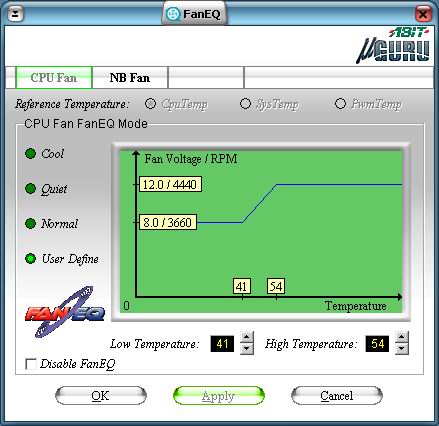
A couple of words on the "Bus Disconnect" feature. Remember that this feature is responsible for disconnecting the processor from the bus during downtime periods. 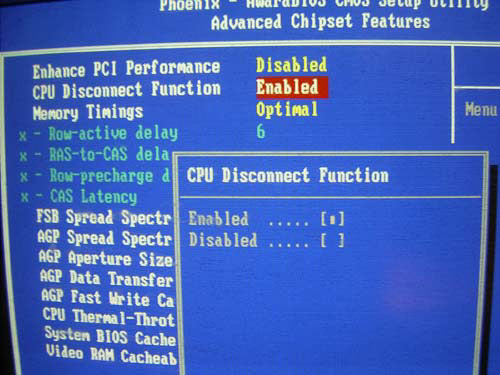
This results in an essential reduction of the processor temperature (and thus the average system temperature). By the way, the function started operating properly after no earlier than version 15 of the BIOS. With the previous versions, enabling the "Bus Disconnect" feature resulted in some performance drop. Now let's look into the FlashMenu, a program for BIOS update from within Windows. 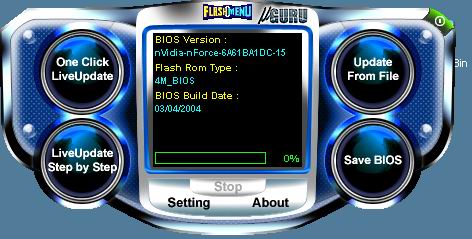
The utility is very handy to use: the BIOS can be updated in a few mouse clicks. Lastly, the most attractive feature - the mGuru. The idea behind it is about storing several BIOS setting profiles in memory. That is, all the BIOS settings can be stored in the mGuru memory as a named profile. For example, you can make two profiles: "Normal" and "Overclocked", respectively with the nominal settings and overclocking parameters. This feature is especially useful in case of frequent memory changes: 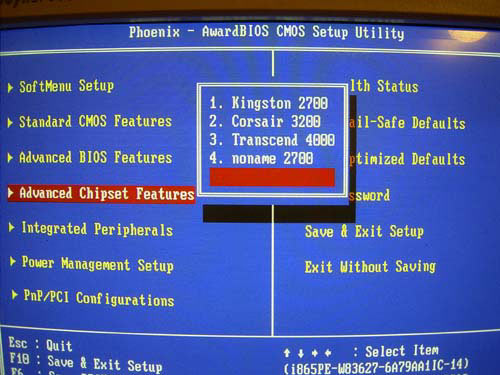
To store a profile, the F6 key is used, and F7 - for loading. Personally, I created a profile for the "cold" system. The clock speed for the Barton processor was set to 1000 MHz (200x5), while the supply voltage set to the maximum possible = 1.375V. In this mode, the processor emits some less heat, so to cool it down a cooler with the maximum decelerated fan would suffice (which means noiseless operation). Anyway, to provide stable operation at 1000 MHz, it is quite enough to set Vcore to 1.1V (many motherboards support such wide range), which allows to build a system with fully passive cooling of the processor. Overclocking and stabilityDuring the tests, I had nothing to complain regarding the operation stability of the board running both at rated and increased speeds. The power converter is made on the 3-channel scheme having five 3300 mkF and four 2200 mkF capacitors. At that, the board is completely identical to NF7-S. More than that, even the design of the power supply module is identical in both the boards. 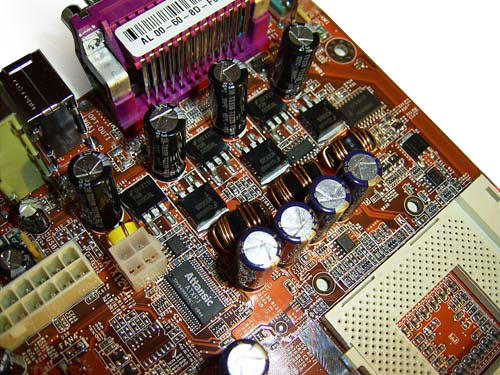
We are now moving on to the overclocking tools which are traditionally gathered in the SoftMenu section. 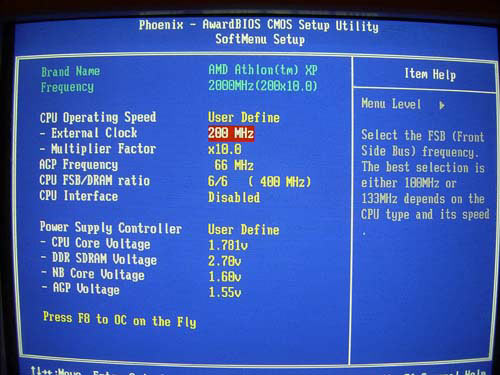
Abit AN7 allows varying the system bus speed within 100 to 300 MHz in 1-2 MHz increments. 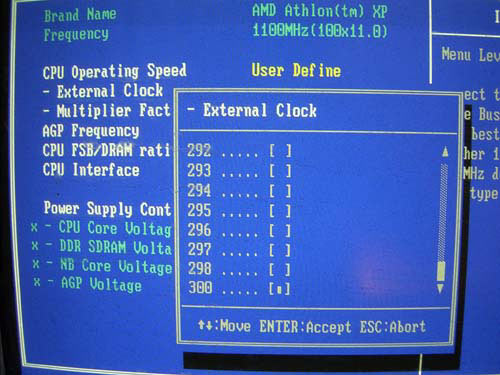
The next item deals with changing the 5-bit encoded multiplier. As we remember, this feature is supported by merely few boards: ( Abit NF7-S, Acorp 7NFU400, Gigabyte 7N400 and Soltek 75FRN2-L ), and allows using multipliers set to >=13. 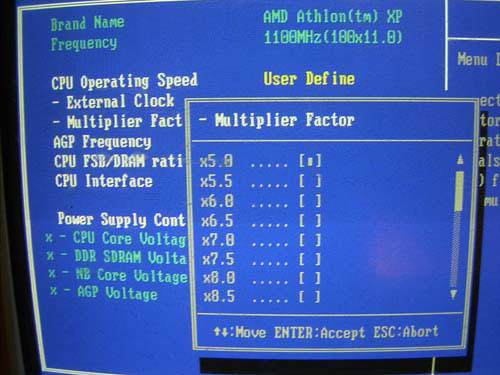
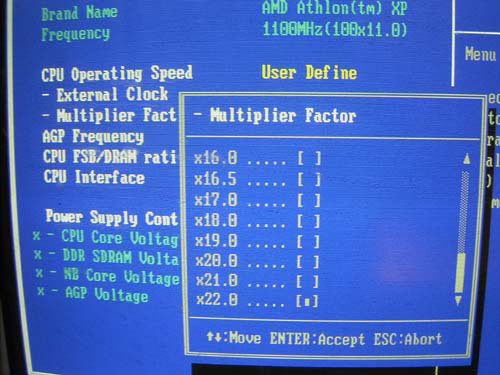
In AN7, the multiplier is adjustable within 5 to 22 in 0.5-1 increments. And, there is a "fly in the ointment" though: the board won't start with the multiplier set to =9. In fact, the same problem was observed also in NF7-S as well. The next important item is raising the processor voltage (Vcore). The board offers a wide adjustment range: within 1.375V to 2.313V in 0.031V increments. 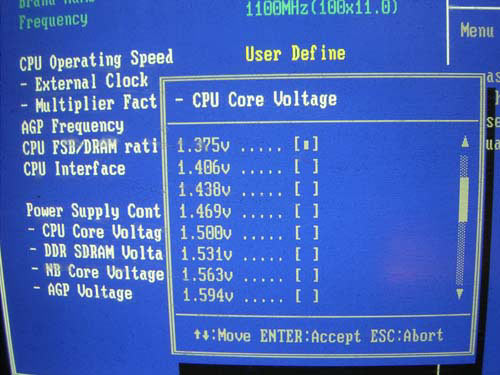
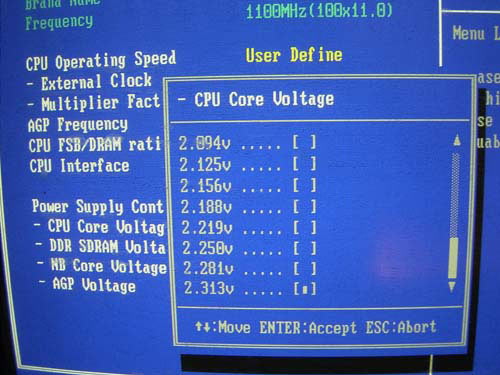
The next item allows raising the memory voltage (Vmem). The overclocker can raise the Vmem from the nominal 2.5V up to 3.2V (in 0.05-0.1V increments: a really powerful feature as compared to competitor solutions). 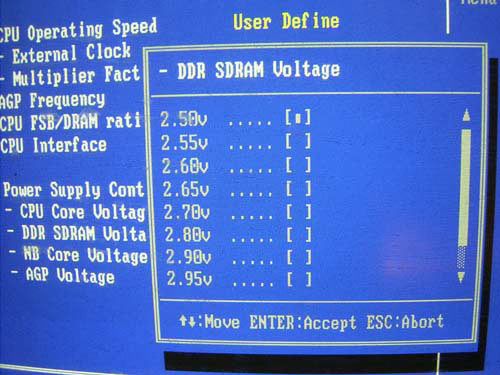
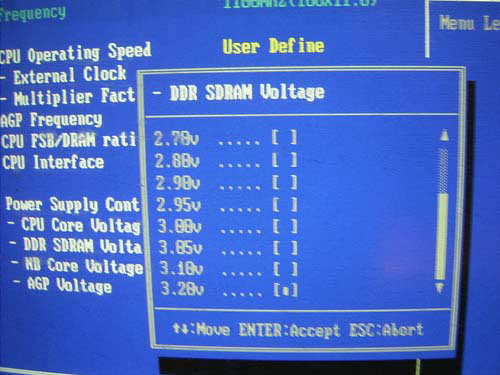
The remaining features are also powerful indeed: AN7 allows raising the chipset voltage - from 1.6V to 1.75V in 0.05V increments, 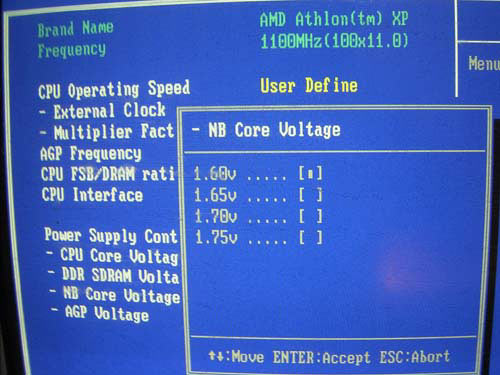
as well as raising the AGP voltage from 1.5V to 1.65V in 0.05V increments. 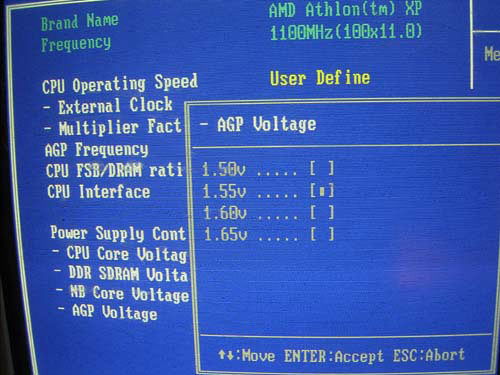
As regards the practical overclocking, I was able to attain stable operation at FSB=225 MHz using memory of the types Transcend PC4000 (DDR500), at 217MHz with Kingston HyperX PC2700, and at 220 MHz with Corsair PC3200 TwinX memory. In all the cases, the system was running in the dual-channel synchronous mode. 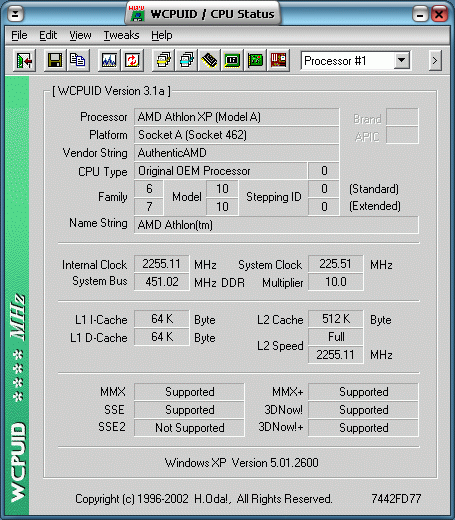
It makes sense mentioning a program for overclocking the system from within Windows - the OC Guru. 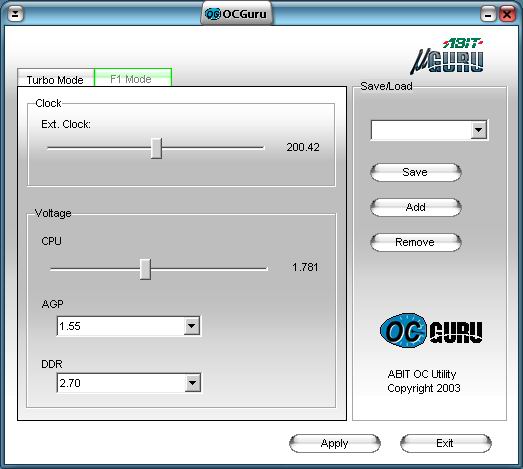
Its potentials are anyway restricted (e.g., there is no way changing the multiplier), so I wouldn't recommend it to the beginner users. Summing it up, I can say that Abit AN7 offers powerful overclocking tools: it offers a very high margin for Vcore raise, with the no less memory voltage adjustment range. The board also allows raising voltage on the actively cooled chipset. PerformanceI took Albatron KX18D Pro II (nVidia nForce II 400 Ultra) and Epox 8KRA2+ (VIA KT600) as contenders to the board in question. In our test configuration, we used the following hardware:
On both the boards, the following memory latency timings were set:
Let's first take a look at the results of synthetic benchmarks. 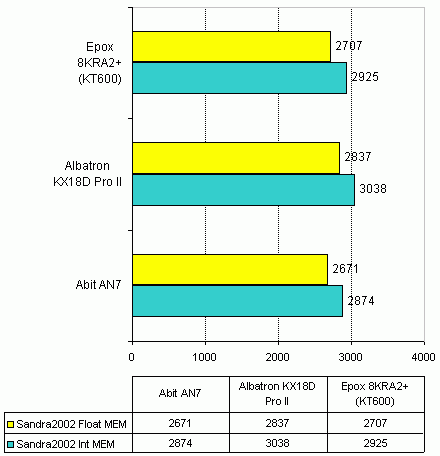
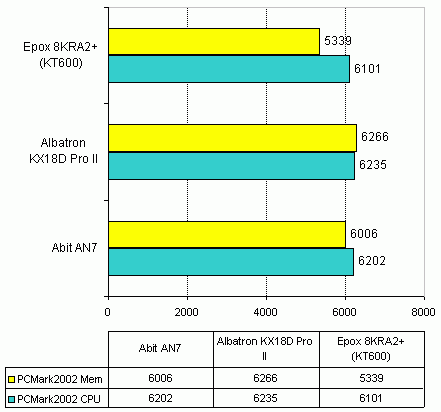
Now on to the gaming benchmarks. 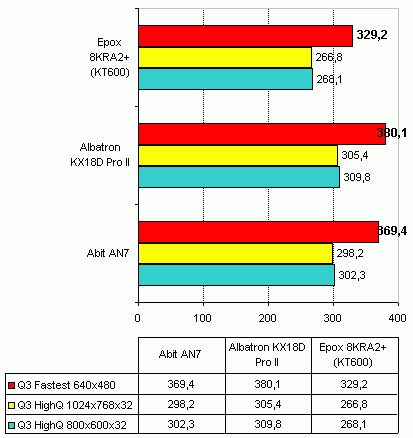
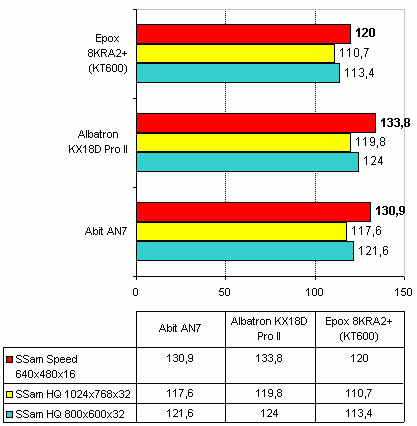
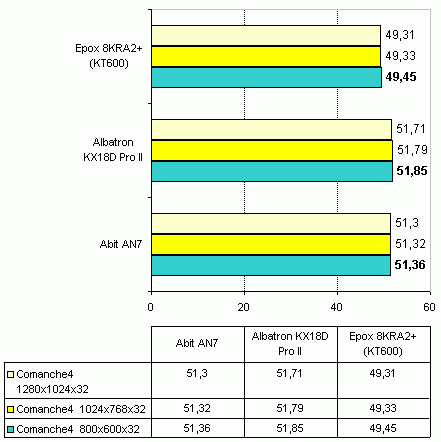
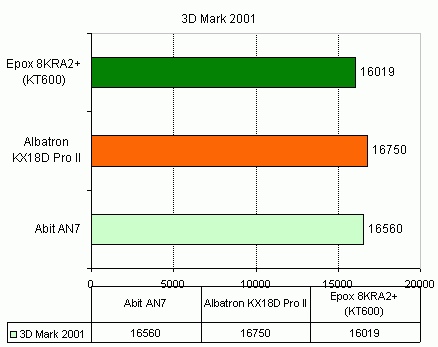
Final WordsThe most essential conclusion: Abit AN7 is at least no worse than the Abit NF-S rev 2.0 motherboard. To be more specific, it is more attractive in terms of functionality: it offers better quality of integrated audio (in my humble opinion), wide potentials for adjusting the rotation of fans, support for BIOS setting profiles. But this was achieved due to a trade-off: the price of AN7 is somewhere in between 115-120$, while that for NF7-S is about ~110$ (including the Serillel adapter). The difference is not that great, but keep in mind that Abit motherboards are relatively more expensive as compared to other boards offering the MCP-T (for comparison - Epox 8RDA+ rev 2.x costs 83-85$). Actually, Abit produce has never been cheap... As regards the mGuru chip and accompanying utilities, the real benefit comes only from the FanEQ and BIOS setting profiles. Resume: those who already have NF7-S do not need to replace it with AN7. But the buyer of a new computer can absolutely safely choose between AN7 and NF7-S: the difference between them is only in the mGuru chip. ConclusionPros:
Read more on this topicA Roundup of nVidia nForce II 400 Ultra Motherboards |
||||||||||||||||||||||||||||||||||||||||||||||||||||||||
|
|||||